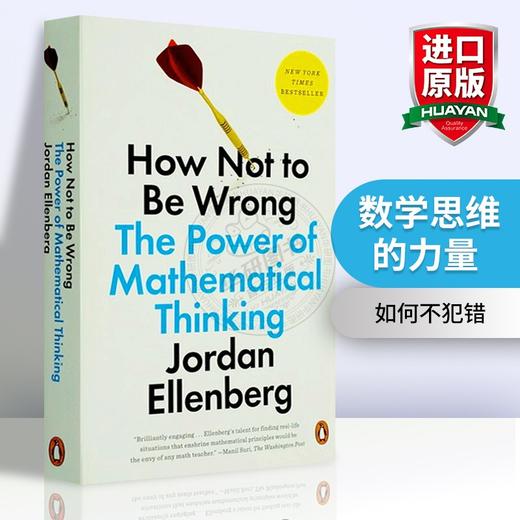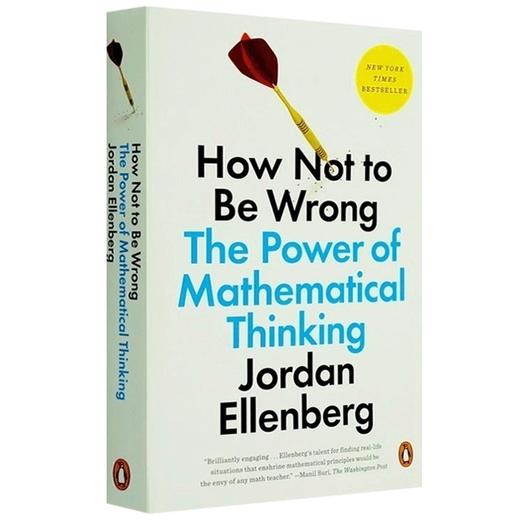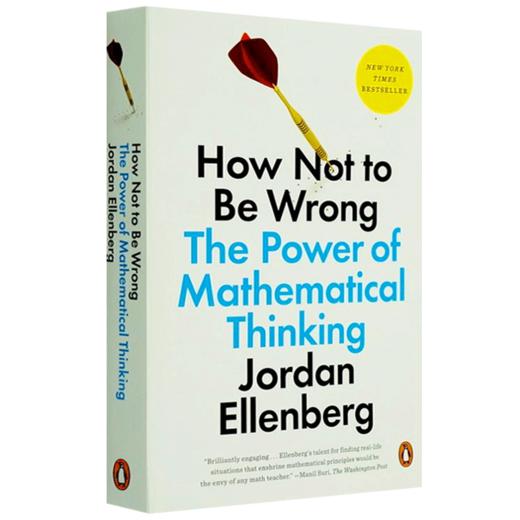魔鬼数学 大数据时代 数学思维的力量 英文原版 How Not to Be Wrong 如何不犯错英文版 进口概率和统计书 比尔盖茨书单
| 运费: | ¥ 0.00-999.00 |
| 库存: | 36 件 |
商品详情
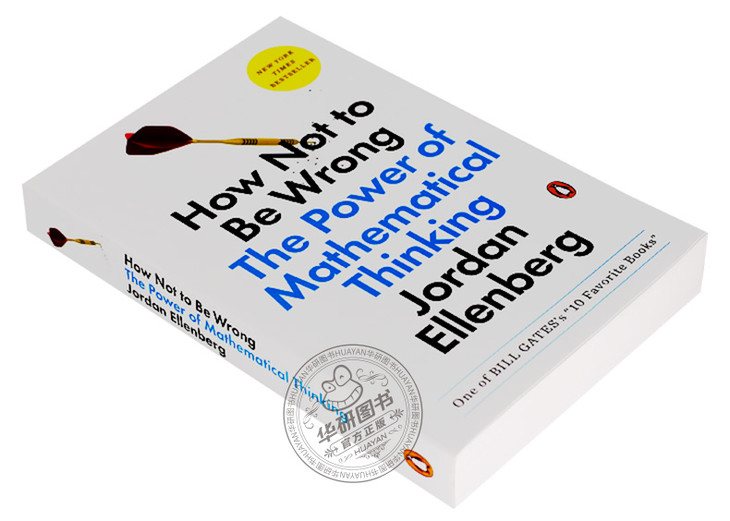
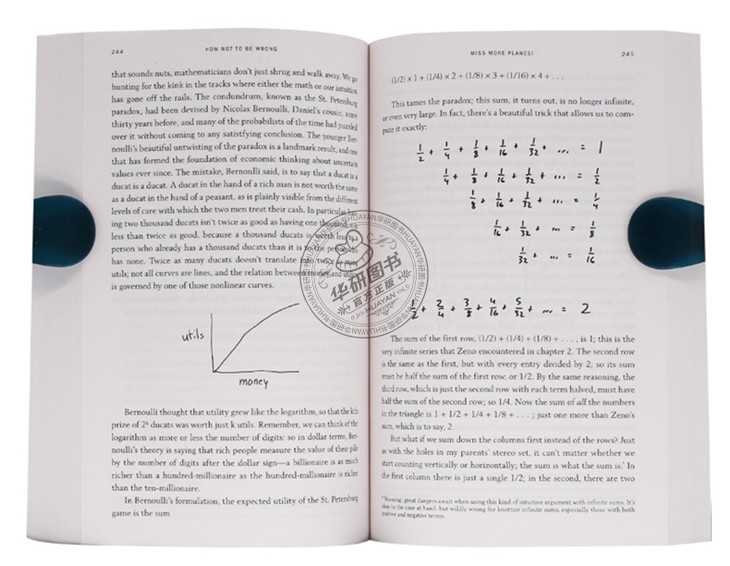
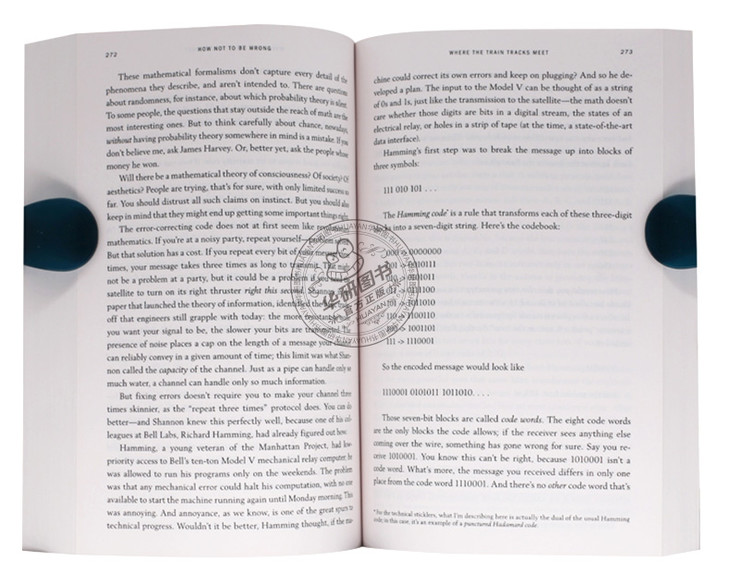
 书名:How Not to Be Wrong: The Power of Mathematical Thinking如何不犯错:数学思维的力量
书名:How Not to Be Wrong: The Power of Mathematical Thinking如何不犯错:数学思维的力量
作者:Jordan Ellenberg乔丹·艾伦伯格
出版社名称:Penguin Books
出版时间:2015
语种:英文
ISBN:9780143127536
商品尺寸:13.8 x 2.6 x 21.3 cm
包装:平装
页数:480 (以实物为准)
★比尔•盖茨2016年暑期书单
你应该提前多长时间到达机场?
民意调查的结果真的能代表人们的意愿吗?
为什么父母都是高个子,孩子的身高却比较矮?
用什么策略买彩票才能中大奖?
How Not to Be Wrong: The Power of Mathematical Thinking《如何不犯错:数学思维的力量》运用数学方法分析和解决了很多的日常生活问题,帮助数学门外汉习得用数学思维思考问题的技能。
作者用数学这条主线穿起了时空,从每时每刻到宇宙空间,中间还穿插了很多人和事物,比如棒球、里根经济学、伏尔泰、意大利文艺复兴时期的绘画、人造语言等。
How Not to Be Wrong: The Power of Mathematical Thinking《如何不犯错:数学思维的力量》带领我们踏上了一段精彩绝伦的数学思维之旅,旅行过后,相信你可以成为一个更棒的思考者。作者从历史及近期的理论发展中汲取精华,向我们展示了数学知识的魅力和力量。数学可以让我们更好地思考:它可以磨练我们的直觉,让我们的判断更敏锐,它还可以驯服不确定性,让我们更深入地了解世界的结构和逻辑。
拥有了数学工具,我们就可以把那些我们想当然的事情看得更透彻,从而做出正确的决策。
名人推荐:
The Freakonomics of math—a math-world superstar unveils the hidden beauty and logic of the world and puts its power in our hands
The math we learn in school can seem like a dull set of rules, laid down by the ancients and not to be questioned. In How Not to Be Wrong, Jordan Ellenberg shows us how terribly limiting this view is: Math isn’t confined to abstract incidents that never occur in real life, but rather touches everything we do—the whole world is shot through with it.
Math allows us to see the hidden structures underneath the messy and chaotic surface of our world. It’s a science of not being wrong, hammered out by centuries of hard work and argument. Armed with the tools of mathematics, we can see through to the true meaning of information we take for granted: How early should you get to the airport? What does “public opinion” really represent? Why do tall parents have shorter children? Who really won Florida in 2000? And how likely are you, really, to develop cancer?
How Not to Be Wrong presents the surprising revelations behind all of these questions and many more, using the mathematician’s method of analyzing life and exposing the hard-won insights of the academic community to the layman—minus the jargon. Ellenberg chases mathematical threads through a vast range of time and space, from the everyday to the cosmic, encountering, among other things, baseball, Reaganomics, daring lottery schemes, Voltaire, the replicability crisis in psychology, Italian Renaissance painting, artificial languages, the development of non-Euclidean geometry, the coming obesity apocalypse, Antonin Scalia’s views on crime and punishment, the psychology of slime molds, what Facebook can and can’t figure out about you, and the existence of God.
Ellenberg pulls from history as well as from the latest theoretical developments to provide those not trained in math with the knowledge they need. Math, as Ellenberg says, is “an atomic-powered prosthesis that you attach to your common sense, vastly multiplying its reach and strength.” With the tools of mathematics in hand, you can understand the world in a deeper, more meaningful way. How Not to Be Wrong will show you how.
Review
“Brilliantly engaging... Ellenberg’s talent for finding real-life situations that enshrine mathematical principles would be the envy of any math teacher. He presents these in fluid succession, like courses in a fine restaurant, taking care to make each insight shine through, unencumbered by jargon or notation. Part of the sheer intellectual joy of the book is watching the author leap nimbly from topic to topic, comparing slime molds to the Bush-Gore Florida vote, criminology to Beethoven’s Ninth Symphony. The final effect is of one enormous mosaic unified by mathematics.” —Manil Suri, The Washington Post
“Easy to follow, humorously presented... This book will help you to avoid the pitfalls that result from not having the right tools. It will help you realize that mathematical reasoning permeates our lives—that it can be, as Mr. Ellenberg writes, a kind of ‘X-ray specs that reveal hidden structures underneath the messy and chaotic surface of the world.’” — Mario Livio, The Wall Street Journal
“Witty, compelling, and just plain fun to read... How Not to Be Wrong can help you explore your mathematical superpowers.” — Evelyn Lamb, Scientific American
“Mathematicians from Charles Lutwidge Dodgson to Steven Strogatz have celebrated the power of mathematics in life and the imagination. In this hugely enjoyable exploration of everyday maths as ‘an atomic-powered prosthesis that you attach to your common sense,’ Jordan Ellenberg joins their ranks. Ellenberg, an academic and Slate’s ‘Do the Math’ columnist, explains key principles with erudite gusto—whether poking holes in predictions of a U.S. ‘obesity apocalypse,’ or unpicking an attempt by psychologist B. F. Skinner to prove statistically that Shakespeare was a dud at alliteration.” —Nature
“Refreshingly lucid while still remaining conceptually rigorous, this book lends insight into how mathematicians think—and shows us how we can start to think like mathematicians as well.” —The New York Times Book Review
“A poet-mathematician offers an empowering and entertaining primer for the age of Big Data.... A rewarding popular math book for just about anyone.” — Laura Miller, Salon
“Ellenberg tells engaging, even exciting stories about how ‘the problems we think about every day—problems of politics, of medicine, of commerce, of theology—are shot through with mathematics.’” —The Washington Post (blog)
“Wry, accessible, and entertaining... Ellenberg finds the commonsense math at work in the everyday world, and his vivid examples and clear descriptions show how ‘math is woven into the way we reason.’” —Publishers Weekly (starred review)
“Witty and expansive, Ellenberg’s math will leave readers informed, intrigued, and armed with plenty of impressive conversation starters.” —Kirkus Reviews
如果你是一个有“数学焦虑症”的人,你可能不会相信有一天你会爱上数学。
原因在于,我们在学校所学的数学知识看上去不过是一堆沉闷的规则、定律和公理,都是前人传下来的,而且是不容置疑的。在How Not to Be Wrong《如何不犯错:数学思维的力量》中,世界知名数学家乔丹·艾伦伯格告诉我们这样的认识是错误的。数学与我们所做的每一件事都息息相关,可以帮助我们洞见在混沌和嘈杂的表象之下日常生活的隐性结构和秩序。数学是一门告诉我们“如何做才不会犯错”的科学,是经年累月的努力、争论所锤炼出来的。
乔丹·艾伦伯格(Jordan Ellenberg),美国威斯康星大学数学系教授。他在世界范围内发表他的关于数论研究的演讲,并于2013年在世界zui大的数学会议——数学联合会议上做主题演讲。他的文章主要发表在《连线》《纽约时报》《华盛顿邮报》《华尔街日报》《波士顿环球报》等媒体上,他还为《石板》杂志写作“Do the Math”专栏文章,十分受欢迎。
Jordan Ellenberg is the John D. MacArthur Professor of Mathematics at the University of Wisconsin-Madison and a 2015 Guggenheim fellow. He has lectured around the world on his research in number theory and delivered one of the invited addresses at the 2015 Joint Mathematics Meetings, the largest math conference in the world. His writing has appeared in The New York Times, The Washington Post, The Wall Street Journal, The Boston Globe, Wired, and The Believer, and he has been featured on the Today show and NPR’s All Things Considered. He writes a popular column called “Do the Math” for Slate.
WHEN AM I GOING TO USE THIS?
Right now, in a classroom somewhere in the world, a student is mouthing off to her math teacher. The teacher has just asked her to spend a substantial portion of her weekend computing a list of thirty definite integrals.
There are other things the student would rather do. There is, in fact, hardly anything she would not rather do. She knows this quite clearly, because she spent a substantial portion of the previous weekend computing a different—but not very different—list of thirty definite integrals. She doesn’t see the point, and she tells her teacher so. And at some point in this conversation, the student is going to ask the question the teacher fears most:
“When am I going to use this?”
Now the math teacher is probably going to say something like:
“I know this seems dull to you, but remember, you don’t know what career you’ll choose—you may not see the relevance now, but you might go into a field where it’ll be really important that you know how to compute definite integrals quickly and correctly by hand.”
This answer is seldom satisfying to the student. That’s because it’s a lie. And the teacher and the student both know it’s a lie. The number of adults who will ever make use of the integral of (1 − 3x + 4x2)−2 dx, or the formula for the cosine of 3θ, or synthetic division of polynomials, can be counted on a few thousand hands.
The lie is not very satisfying to the teacher, either. I should know: in my many years as a math professor I’ve asked many hundreds of college students to compute lists of definite integrals.
Fortunately, there’s a better answer. It goes something like this:
“Mathematics is not just a sequence of computations to be carried out by rote until your patience or stamina runs out—although it might seem that way from what you’ve been taught in courses called mathematics. Those integrals are to mathematics as weight training and calisthenics are to soccer. If you want to play soccer—I mean, really play, at a competitive level—you’ve got to do a lot of boring, repetitive, apparently pointless drills. Do professional players ever use those drills? Well, you won’t see anybody on the field curling a weight or zigzagging between traffic cones. But you do see players using the strength, speed, insight, and flexibility they built up by doing those drills, week after tedious week. Learning those drills is part of learning soccer.
“If you want to play soccer for a living, or even make the varsity team, you’re going to be spending lots of boring weekends on the practice field. There’s no other way. But now here’s the good news. If the drills are too much for you to take, you can still play for fun, with friends. You can enjoy the thrill of making a slick pass between defenders or scoring from distance just as much as a pro athlete does. You’ll be healthier and happier than you would be if you sat home watching the professionals on TV.
“Mathematics is pretty much the same. You may not be aiming for a mathematically oriented career. That’s fine—most people aren’t. But you can still do math. You probably already are doing math, even if you don’t call it that. Math is woven into the way we reason. And math makes you better at things. Knowing mathematics is like wearing a pair of X-ray specs that reveal hidden structures underneath the messy and chaotic surface of the world. Math is a science of not being wrong about things, its techniques and habits hammered out by centuries of hard work and argument. With the tools of mathematics in hand, you can understand the world in a deeper, sounder, and more meaningful way. All you need is a coach, or even just a book, to teach you the rules and some basic tactics. I will be your coach. I will show you how.”
For reasons of time, this is seldom what I actually say in the classroom. But in a book, there’s room to stretch out a little more. I hope to back up the grand claims I just made by showing you that the problems we think about every day—problems of politics, of medicine, of commerce, of theology—are shot through with mathematics. Understanding this gives you access to insights accessible by no other means.
Even if I did give my student the full inspirational speech, she might—if she is really sharp—remain unconvinced.
“That sounds good, Professor,” she’ll say. “But it’s pretty abstract. You say that with mathematics at your disposal you can get things right you’d otherwise get wrong. But what kinds of things? Give me an actual example.”
And at that point I would tell her the story of Abraham Wald and the missing bullet holes.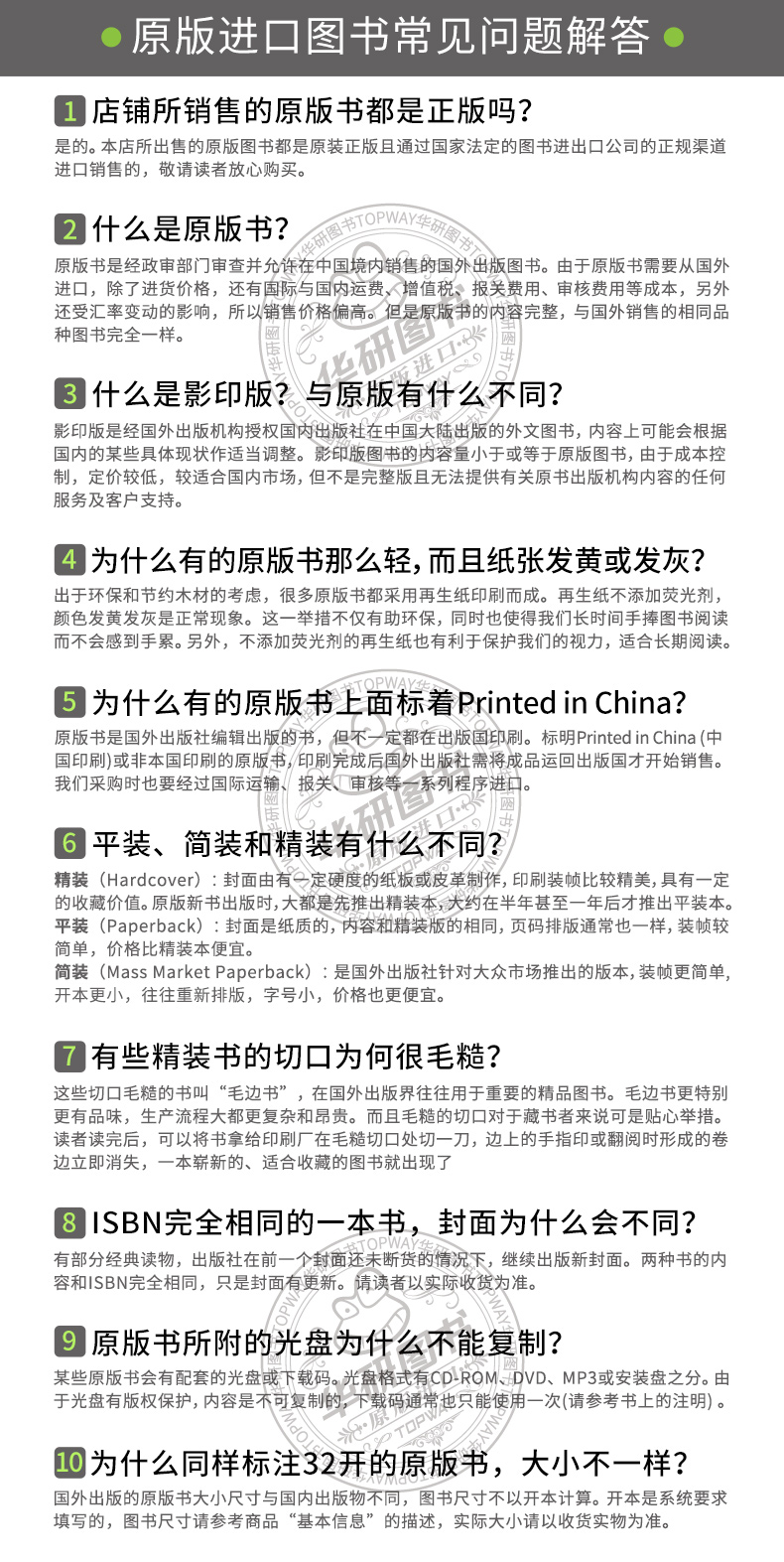
- 华研外语 (微信公众号认证)
- 本店是“华研外语”品牌商自营店,全国所有“华研外语”、“华研教育”品牌图书都是我司出版发行的,本店为华研官方源头出货,所有图书均为正规正版,拥有实惠与正版的保障!!!
- 扫描二维码,访问我们的微信店铺
- 随时随地的购物、客服咨询、查询订单和物流...
